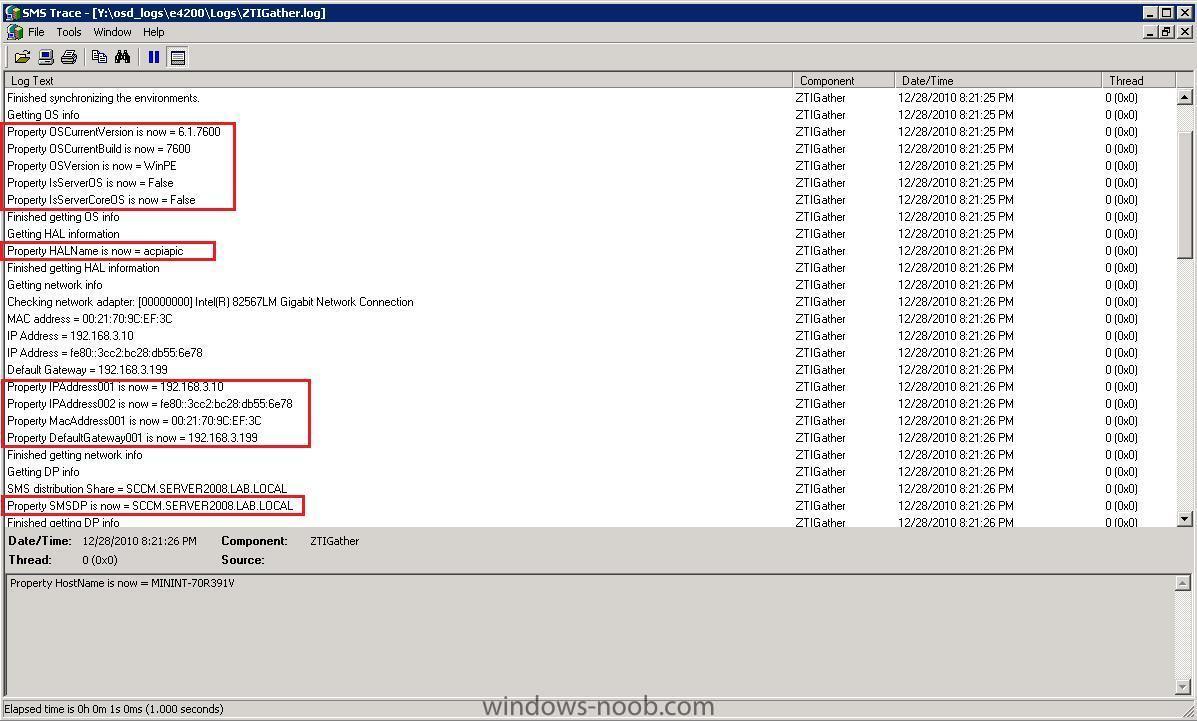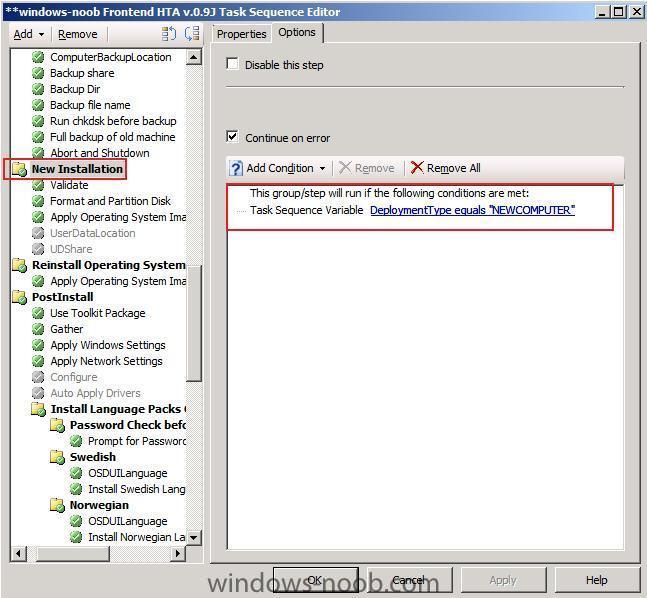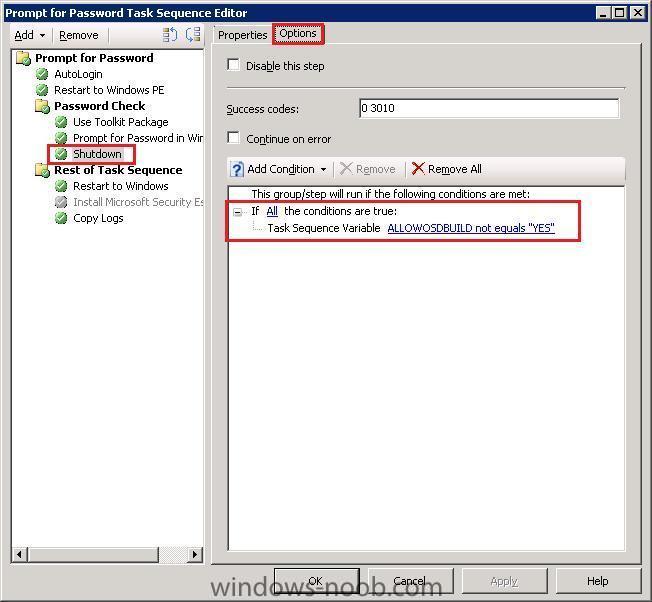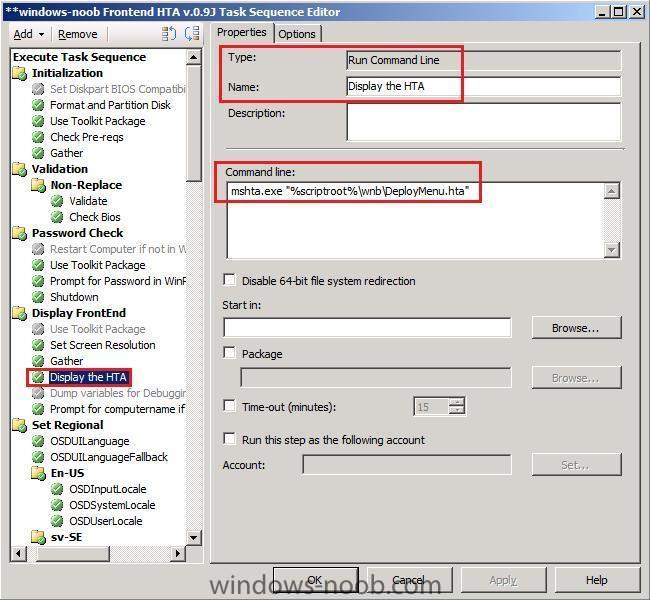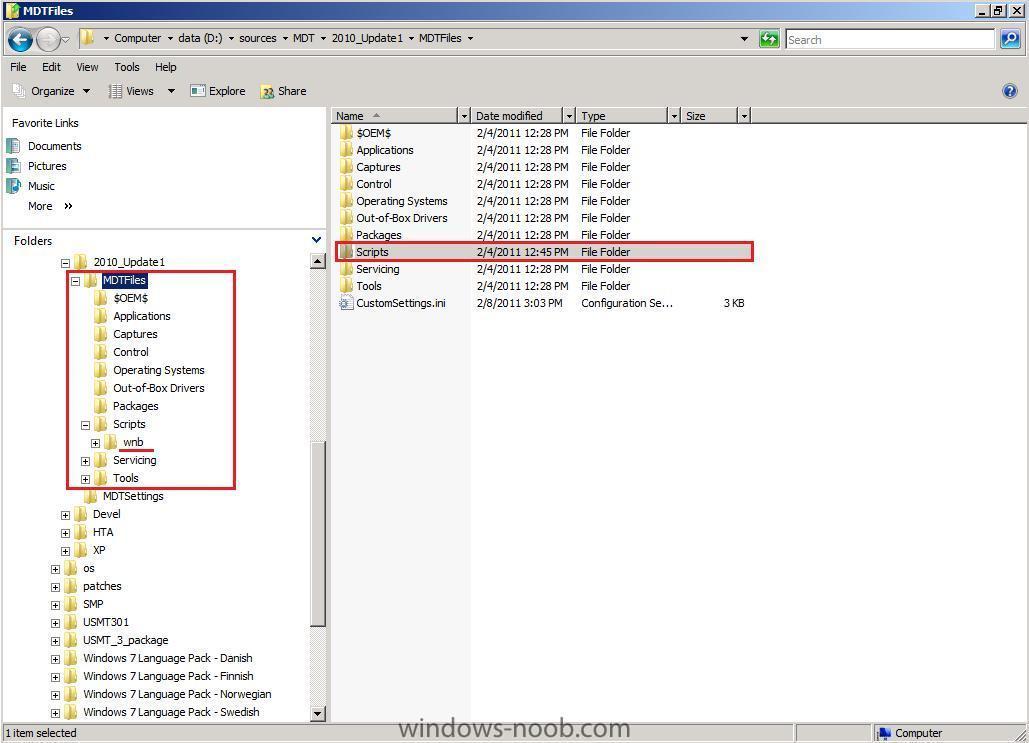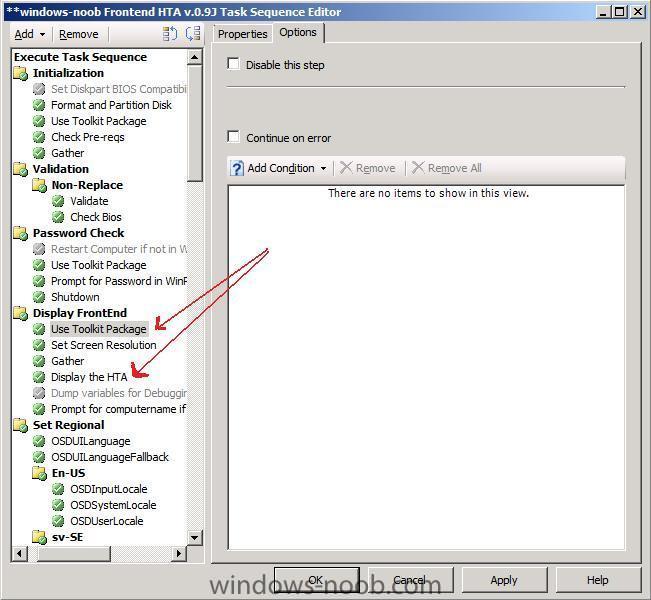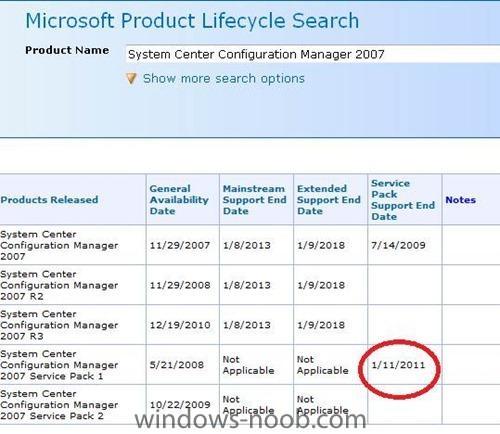-
Posts
9211 -
Joined
-
Last visited
-
Days Won
367
Everything posted by anyweb
-

How can I hide the Task Sequence Progress Window
anyweb posted a question in Frontends, HTA's and Web Services
by default when you execute some action (like displaying a HTA or a script or whatever) during a Task Sequence in Configmgr, the Installation Progress window will be present Infront of your work of art, to avoid this, you can use a backend javascript .js file (such as the deployment.js included in the Windows-noob.com Multipurpose FrontEnd HTA), include the following lines to hide the progress bar while the HTA is being displayed var oTSProgressUI = new ActiveXObject("Microsoft.SMS.TSProgressUI"); oTSProgressUI.CloseProgressDialog(); your backend Javascript file is in turn referenced by the FrontEnd HTA using the src command eg: <script type="text/javascript" src="DeployMenu.js"></script> -
You can use your FrontEnd HTA to set values (variables) which in turn can be used (or checked for) in your Task Sequence. The FrontEnd can display options to your users like drop down menus or Radio Buttons, which have corresponding backend scripts which set values. In addition, values can be gathered using the MDT ztigather.wsf script, this queries wmi and pulls a whole load of values which in turn are processed by ZTIUtility.vbs, For example, the UUID value of a client is gathered (read) by ZTIgather.wsf, and ZTIutility.vbs sets this value oEnvironment.Item("UUID"). We can create a function in our HTA FrontEnd backend javascript script, to show the value of UUID. function showUUID() { var oEnvironment = new ActiveXObject("Microsoft.SMS.TSEnvironment"); alert(oEnvironment("UUID")); } The script above will only work if a Gather step has taken place beforehand. When ZtiGather.wsf runs, it produces a log file (ztigather.log) and in that log file you can see what it has detected, anything that is marked as Property can be ‘used’ or displayed in our HTA, Javascript (*.js) backend sample The below script will set a variable called DEPLOYMENTTYPE. It sets it to a value which in turn we'll check for in our task sequence. var oEnvironment = new ActiveXObject("Microsoft.SMS.TSEnvironment"); oEnvironment("DEPLOYMENTTYPE") = "NEWCOMPUTER"; The task sequence has a Group which checks for the value of that variable and if=NEWCOMPUTER It does some actions. windows Scripting File (*.wsf) backend sample The below sample code sets a variable called ALLOWOSDBUILD, which is checked for in the task sequence, if the value=NO then the task sequence shutsdown the computer. <job id="PromptForPassword"> <script language="VBScript" > Dim env,oTSProgressUI,MyPass Set env = CreateObject("Microsoft.SMS.TSEnvironment") set oTSProgressUI = CreateObject("Microsoft.SMS.TSProgressUI") oTSProgressUI.CloseProgressDialog() env("ALLOWOSDBUILD") = "NO" MyPass=Inputbox("Please enter the Password to start the OS Deployment") If MyPass = "password" then env("ALLOWOSDBUILD") = "YES" End If </script> </job> and below is a VBS example set env = CreateObject ("Microsoft.SMS.TSEnvironment") strTask = env("_SMSTSPackageName") ' log file to be used strFile = "\\server\log$\" & strTask & ".txt" the above writes out the Task Sequence name as the 'name' of the log file.
-
To add your HTA to your task sequence, you'll first need a boot image with HTA support. Once you have that the rest is easy. At the beginning of your task sequence create a Run command Line step with the following in it mshta.exe "%scriptroot%\wnb\Deploymenu.hta" let me explain what is happening in this step... The mshta.exe file is like a web browser and displays our HTA (hypertext application). you'll notice i'm using a path to our HTA which is "%scriptroot%\wnb\Deploymenu.hta" that is because I place the HTA files in a sub directory of my MDT toolkit scripts directory (MDT Toolkit scripts directory=%scriptroot%). This is not possible without a Use Toolkit Package step shortly before this step otherwise the %scriptroot% variable won't be set, so prior to this in my Task Sequence I have a Use Toolkit Package step. To copy your HTA file(s) to a sub directory in your MDT Toolkit package, locate the package source in ConfigMgr, find the scripts directory and create a new sub directory called My_Custom_Scripts (or whatever you want) which contains your scripts. In my example the sub directory is called wnb and I place my HTA file and all supporting scripts in there. Don't forget to Update your distribution points for your MDT Toolkit package after copying the new scripts/files.
-
here are some sample task sequences for just that purpose http://blogs.technet.com/b/mniehaus/archive/2010/07/20/mdt-2010-update-1-fixes-to-configmgr-state-migration-point-scenarios.aspx or if you want to get very cool you could try the windows-noob.com MultiPurpose HTA which does side-by-side and other scenarios all in one task sequence
-
here's how http://blogs.technet.com/b/mniehaus/archive/2010/07/20/mdt-2010-update-1-fixes-to-configmgr-state-migration-point-scenarios.aspx
-
After an already long development path, Microsoft has just released the release candidate for Internet Explorer 9, their attempt at turning the tide. They've looked at an impressive 17000 pieces of feedback for the release candidate, and they made lots of changes. There are a lot of changes under the hood. The release candidate adds support for CSS3 2D Transforms, HTML5 Geolocation, a set of HTML5 semantic elements, and the HTML5 canvas globalCompositeOperation property. They also improved the performance of CanvasPixelArray. "The IE9 RC is faster with real world sites. In addition to making the script engine faster, we've improved and tuned the rest of the browser as well. You'll find that Gmail, Office Web Applications, and many other sites are faster as a result of scenario tuning, network cache tuning, and new compiler optimizations," details Dean Hachamovitch, Microsoft's corporate vice president for Internet Explorer, "You'll also find that the RC of IE9 often uses megabytes less memory than the beta because of changes like delayed image decoding. We've also improved the performance of things many people do every day, like find on page, and made improvements which extend battery life." Interface-wise, the biggest change is the addition of an option to display the tab bar on an additional row. Sadly, you can't place these tabs atop the address bar where it belongs according to the Gospel Of Chrome (the One True browser interface). Another issue is the font rendering, which is still fuzzy due to the DirectWrite support. Why IE9 can't just use my global font settings is beyond me. It might sound petty to some, but it's frickin' 2011 and I demand consistent font rendering. Whether it's the fuzzy but shape-accurate Mac OS X variant, or the sharp but shape-inaccurate variant in Windows - they're both fine as long as it's an either-or thing! You can download the release candidate today. via > http://www.osnews.com/story/24398/Internet_Explorer_9_Release_Candidate_Released
-
Yesterday, Microsoft officially handed off the final release (RTM) of Windows 7 and Windows Server 2008 R2 Service Pack 1 (SP1) to their OEM partners. On February 16th Windows 7 and Windows Server 2008 R2 SP1 will be available for MSDN and TechNet Subscribers as well as Volume License customers. On February 22nd, Windows 7 and Windows Server 2008 R2 SP1 will become generally available for folks to download via the Microsoft Download Center and available on Windows Update. For Windows 7, SP1 will help keep your PCs well supported by delivering ongoing updates, many of which have been made previously available through Windows Update. It also includes client-side support for RemoteFX and Dynamic Memory which are two new virtualization features enabled in Windows Server 2008 R2 SP1. Read more about those updates here from the Windows Server Team. via > http://windowsteamblog.com/windows/b/bloggingwindows/archive/2011/02/09/announcing-availability-of-windows-7-and-windows-server-2008-r2-sp1.aspx
-
i think Tim explains it brilliantly here http://deployment.xtremeconsulting.com/2009/11/20/understanding-usmt-with-mdt-2010/
-

Test App created in workbench
anyweb replied to mariano's question in Deploying Windows 10, Windows 8.1, Windows 7 and more...
have you tried using psexec.exe with the system account to install apps ? that gives you a very good idea of how the app will install (or fail) when done during a task sequence -
Microsoft has created an update for USMT 4.0 that adds support for Office 2010. USMT 4.0 migrations of Office 2010 are now supported . You can get the update here: http://support.microsoft.com/kb/2023591 Here are some things you should be aware of: * Certain settings and customizations in MS Word won’t migrate from any version to Word 2010, because of with the way Word is designed and how data is stored in “HKEY_CURRENT_USER\software\Microsoft\Office\<OfficeVersion>\Word\Data". * Many Office settings (across all Office apps) won’t migrate when going from 32-bit Office to 64-bit Office. This is due to the way that the settings are stored in 64-bit Office installations. * If you’ve launched Office on the destination PC as a user before doing the migration of that user’s profile, most of your settings won’t migrate. This happens because Office relies on some code that only runs the first time that an Office app is launched to migrate settings. * This update isn’t a magic bullet. You may still need to do some customization to make USMT fit your particular configuration. The update also fixes a couple of issues around hard-link migration performance when copying a folder with a huge number of files and an issue that affected certain time zones. This post was contributed by David Hornbaker, a Senior Consultant with Microsoft Services - U.S. East Region. Disclaimer: The information on this site is provided "AS IS" with no warranties, confers no rights, and is not supported by the authors or Microsoft Corporation. Use of included script samples are subject to the terms specified in the Terms of Use via > http://blogs.technet.com/b/deploymentguys/archive/2011/02/04/usmt-4-update-released-to-support-office-2010-migrations.aspx
-
Hello everyone, we are extremely pleased to announce that the most recent Gartner Magic Quadrant for PC Configuration Management Life Cycle Management Tools has recognized ConfigMgr as a Leader amongst the industries top competitors. Configuration Manager is noticeably ahead of competitors in the Ability to Execute axis placement. In addition, Gartner quotes that “ConfigMgr appeared in Gartner client buying decisions more frequently than any other product in the market in 2010.” The PCCLM report highlights the following strengths: * ConfigMgr's integration with App-V is tight, which Microsoft tightened further with the R3 release of ConfigMgr. Prior versions of ConfigMgr lacked on-demand (i.e., user-initiated) App-V application delivery, because all App-V changes were a function of the ConfigMgr agent poll, which takes place on a scheduled basis (often only once a day or even less frequently). Now, the App-V client can pull App-V applications from ConfigMgr distribution points on an on-demand basis. * Microsoft is developing tight integration with products in important companion areas — for example, System Center Service Manager and Forefront Endpoint Protection. * ConfigMgr is a stable product. Since its introduction in August 2007, there have been few product bugs. You can read the entire Gartner PCCLM report here. via > http://blogs.technet.com/b/systemcenter/archive/2011/02/04/configuration-manager-2007-r3-has-retained-a-strong-leader-position-in-gartner-s-magic-quadrant-for-pc-configuration-life-cycle-management-pcclm-report.aspx
-
you could try setting the permissions like so http://www.windows-noob.com/forums/index.php?/topic/1090-share-and-ntfs-permissions/
-

Need constant mouse movement
anyweb replied to reem01's question in Windows Deployment Services (WDS)
what bios version on the dell ? is it the latest ? if not upgrade to the latest does it change ? also try using nic drivers from the network card vendor (broadcom or intel) -
if you want to push the images out via PXE then you'll have to install windows deployment services, have you done that yet ?
-

how can I install SCCM 2007 in Windows Server 2008
anyweb replied to anyweb's topic in Configuration Manager 2007
thanks a lot for the kind words -
Hi All, I just wanted to send a quick reminder that System Center Configuration Manager 2007 Service Pack 1 has reached the end of its service pack support date: http://support.microsoft.com/lifecycle/search/default.aspx?sort=PN&qid=null&alpha=System+Center+Configuration+Manager+2007&Filter=FilterNO Note that per the Lifecycle Policy: The Microsoft Support Lifecycle policy requires that the product’s supported service pack be installed to continue to receive support (including security updates). Note new Service Pack Lifecycle Support Policy effective April 13, 2010: http://support.microsoft.com/gp/newSPlifecycle Service Pack Support Policy * When a new service pack is released, Microsoft will provide either 12 or 24 months of support for the previous service pack * Support for the previous service packs is either 12 or 24 months, varying according to the product family (for example, Windows, Office, Servers, or Developer tools) * Support timelines for service packs will remain consistent within the product family * Microsoft will publish specific support timelines for a previous service pack when the new service pack is released * When support for a service pack ends, Microsoft will no longer provide new security updates, hotfixes or other updates for that service pack. Limited break/fix troubleshooting will continue to be available, as described below. * When support for a product ends, support of the service packs for that product will also end. The product’s support lifecycle supersedes the service pack support policy Customers are highly encouraged to stay on a supported service pack to ensure they are on the latest and most secure version of their product. For customers on unsupported service pack versions, Microsoft offers limited troubleshooting support as follows: 1. Limited break/fix support incidents will be provided through Microsoft Customer Service and Support; and through Microsoft’s managed support offerings (such as Premier Support). 2. There will be no option to engage Microsoft’s product development resources, and technical workarounds may be limited or not possible. 3. If the support incident requires escalation to development for further guidance, requires a hotfix, or requires a security update, customers will be asked to upgrade to a supported service pack. via > http://blogs.technet.com/b/configurationmgr/archive/2011/01/24/system-center-configuration-manager-2007-service-pack-1-has-reached-the-end-of-its-service-pack-support-date.aspx
-

Software Update state locked in "Downloading update(s)"
anyweb replied to batmiki's question in Software Update Point
what about this ? http://blogs.technet.com/b/configmgrteam/archive/2011/01/28/known-issue-install-software-updates-action-hangs-on-windows-7.aspx -

SCCM + WSUS - Will not sync to upstream server, WILL sync to MSUpdate...??
anyweb replied to MRaybone's question in Software Update Point
thanks for sharing, we had a similar problem but it was down to WSUS problems on the rollup servers, i'll see if i can dig up that info -

SCCM + WSUS - Will not sync to upstream server, WILL sync to MSUpdate...??
anyweb replied to MRaybone's question in Software Update Point
nice ! and for all the noobs out there tell them where you configured that -
use lpksetup.exe /i example:- lpksetup.exe /i de-DE /r /p %SYSTEMDRIVE%\LangPacks
-
Net Applications reported that Internet Explorer 9 Beta continued its worldwide growth in January. IE9 has been downloaded over 23 million times, and now accounts for 0.5% of all users worldwide while still a beta product. We are pleased to see users continue to leverage Windows 7 capabilities together with IE9 for a more beautiful web experience. On Windows 7, Internet Explorer 9 already accounts for 1.82% of users worldwide. Internet Explorer 8 also continued its rise in January with 1.18% growth according to Net Applications – over one and a half times of the growth of Chrome (0.72%). With 34.79% of users worldwide, Internet Explorer 8 remains the most popular and fastest growing browser in the market. Internet Explorer 6 on the other hand continued its decline, with a 1.77% drop reaching 12.03% in January worldwide. IE6 has dropped 3.9% over the last three months (an average of 1.3% drop per month) and 9.31% from a year ago. During that same time, IE8 has grown 9.15% since January 2010. This trend is even more accelerated in the commercial segment. I blogged last year that IE6 usage share was already at 10.3%, and IE8 at 34.1% last November. Finally, we are glad to see IE9 popularity continue to rise with our developers and partners. More partners are coming online every day, including Gilt, Hi5, and Huffington Post most recently. We look forward to working with our partners in bringing more beautiful web experiences to life. via > http://windowsteamblog.com/ie/b/ie/archive/2011/02/01/internet-explorer-9-reaches-23-million-downloads-and-1-82-share-on-windows-7.aspx?utm_source=twitterfeed&utm_medium=twitter



